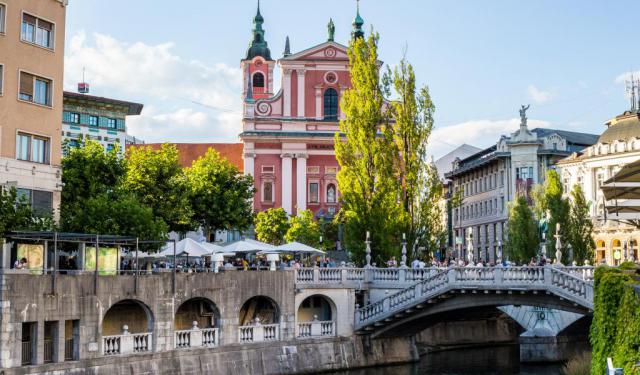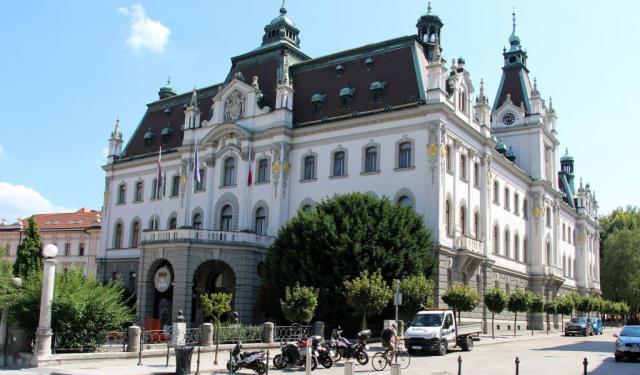
Slovenska matica (Slovene Society Building), Ljubljana
The Slovene Society was established in response to the call of several patriotic associations and individuals from Maribor who advocated for the creation of an institution to publish advanced scholarly literature in Slovene, promote cultural expansion among Slovenes, and develop scientific terminology in the Slovene language. In 1864, the consortium known as "Slovenska matica" was formed, receiving significant financial support from Emperor Francis Joseph I of Austria.
During the early 20th century, the Society flourished, functioning both as a prominent publishing house in the open market, releasing books that became bestsellers, and as an academy of sciences, promoting high culture and maintaining close ties with prestigious institutions such as the Yugoslav Academy of Sciences and Arts in Zagreb, the Serbian Academy of Sciences and Arts in Belgrade, as well as similar organizations in Prague, Kraków, London, and Saint Petersburg.
During the Kingdom of Yugoslavia, the Society expanded its publishing endeavors and played a pivotal role in founding the Slovenian Academy of Sciences and Arts in 1938; however, its activities were abruptly halted by the Nazi German authorities in 1944. Following the Second World War, the communist authorities permitted the Society to be re-established, albeit with reservations about its conservative editorial stance. While most of its assets were nationalized, the society continued its operations with substantial state subsidies.
In the 1980s, the society experienced a revitalization period, focusing on publishing translations of major Western philosophers and political theorists, including authors whose works were considered subversive to the official Socialist ideology. This included works by Heidegger, Machiavelli, Jan Patočka, Unamuno, José Ortega y Gasset, Aurelius Augustinus, and the complete works of Nietzsche.
During the early 20th century, the Society flourished, functioning both as a prominent publishing house in the open market, releasing books that became bestsellers, and as an academy of sciences, promoting high culture and maintaining close ties with prestigious institutions such as the Yugoslav Academy of Sciences and Arts in Zagreb, the Serbian Academy of Sciences and Arts in Belgrade, as well as similar organizations in Prague, Kraków, London, and Saint Petersburg.
During the Kingdom of Yugoslavia, the Society expanded its publishing endeavors and played a pivotal role in founding the Slovenian Academy of Sciences and Arts in 1938; however, its activities were abruptly halted by the Nazi German authorities in 1944. Following the Second World War, the communist authorities permitted the Society to be re-established, albeit with reservations about its conservative editorial stance. While most of its assets were nationalized, the society continued its operations with substantial state subsidies.
In the 1980s, the society experienced a revitalization period, focusing on publishing translations of major Western philosophers and political theorists, including authors whose works were considered subversive to the official Socialist ideology. This included works by Heidegger, Machiavelli, Jan Patočka, Unamuno, José Ortega y Gasset, Aurelius Augustinus, and the complete works of Nietzsche.
Want to visit this sight? Check out these Self-Guided Walking Tours in Ljubljana. Alternatively, you can download the mobile app "GPSmyCity: Walks in 1K+ Cities" from Apple App Store or Google Play Store. The app turns your mobile device to a personal tour guide and it works offline, so no data plan is needed when traveling abroad.
Slovenska matica (Slovene Society Building) on Map
Sight Name: Slovenska matica (Slovene Society Building)
Sight Location: Ljubljana, Slovenia (See walking tours in Ljubljana)
Sight Type: Attraction/Landmark
Guide(s) Containing This Sight:
Sight Location: Ljubljana, Slovenia (See walking tours in Ljubljana)
Sight Type: Attraction/Landmark
Guide(s) Containing This Sight:
Walking Tours in Ljubljana, Slovenia
Create Your Own Walk in Ljubljana
Creating your own self-guided walk in Ljubljana is easy and fun. Choose the city attractions that you want to see and a walk route map will be created just for you. You can even set your hotel as the start point of the walk.
Ljubljana Introduction Walking Tour
Ljubljana is the capital and the heart of Slovenia. Being the country's cultural and political center, it is also Slovenia's largest city and has a long, storied past.
The exact origin of its name is not clear. Some linguists suggest that it may be rooted in "Ljubija," the original name of the Ljubljanica River derived from the Old Slavic male name "Ljubovid,"... view more
Tour Duration: 2 Hour(s)
Travel Distance: 2.0 Km or 1.2 Miles
The exact origin of its name is not clear. Some linguists suggest that it may be rooted in "Ljubija," the original name of the Ljubljanica River derived from the Old Slavic male name "Ljubovid,"... view more
Tour Duration: 2 Hour(s)
Travel Distance: 2.0 Km or 1.2 Miles
Historic Buildings Walking Tour
The Slovenian capital has no shortage of historical buildings. The architectural wealth of Ljubljana accumulated over the years received a significant boost in the early 20th century thanks to the famous Slovenian architect, Joze Plecnik, a classicist, who tried to model the city on ancient Athens.
Among the notable local landmarks is the Ljubljana Central Pharmacy, a testament to the... view more
Tour Duration: 2 Hour(s)
Travel Distance: 2.8 Km or 1.7 Miles
Among the notable local landmarks is the Ljubljana Central Pharmacy, a testament to the... view more
Tour Duration: 2 Hour(s)
Travel Distance: 2.8 Km or 1.7 Miles


